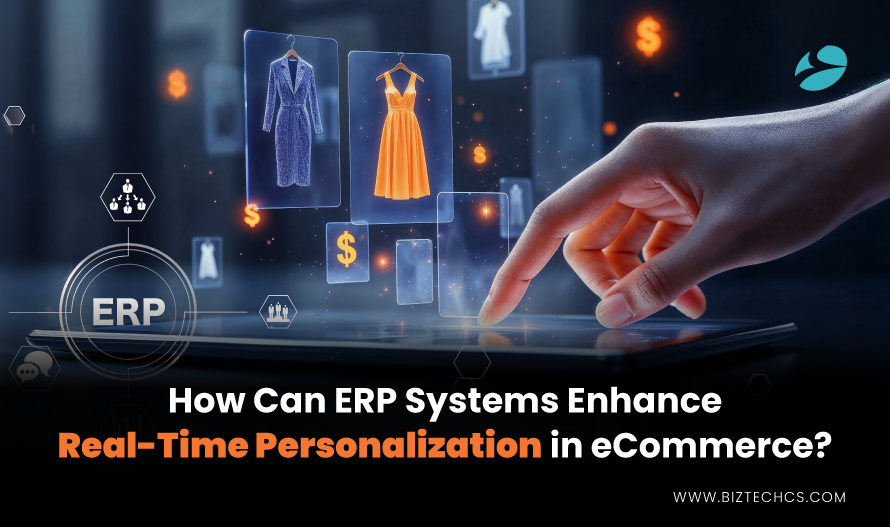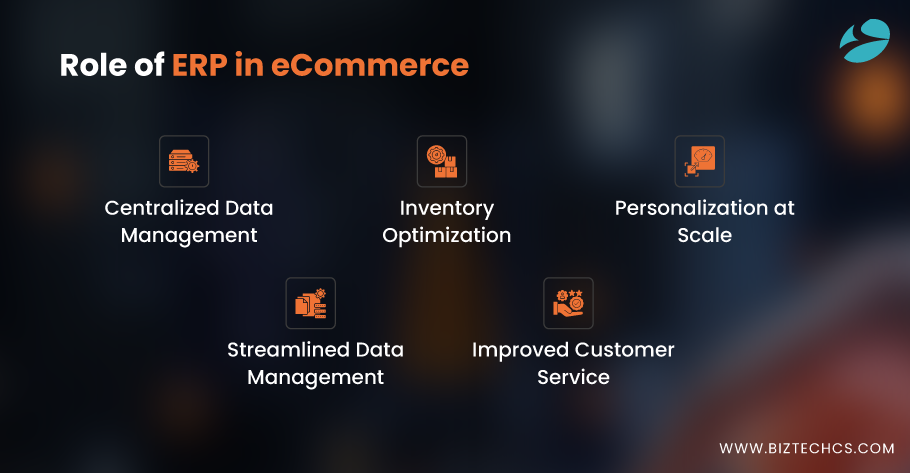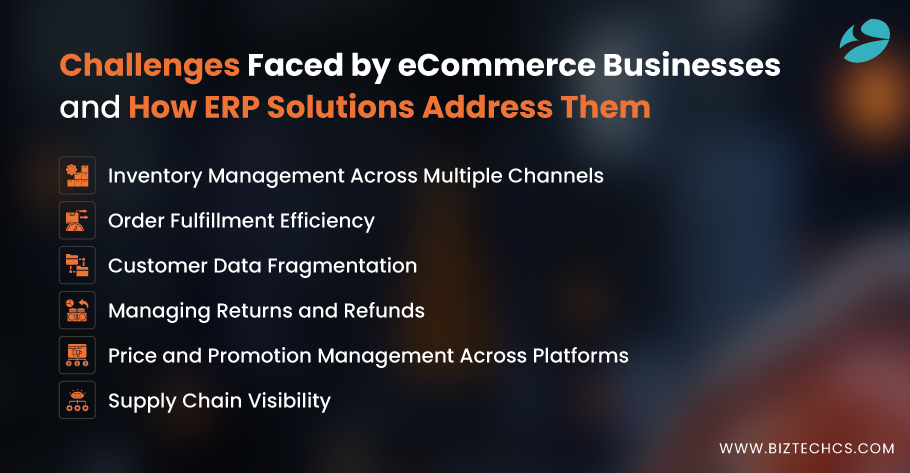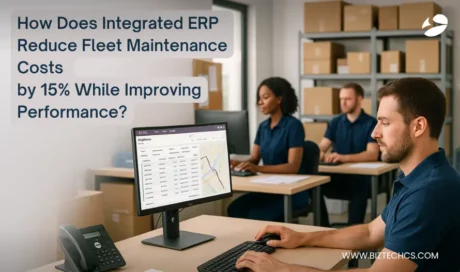How Can ERP Systems Enhance Real-Time Personalization in eCommerce?
05 May, 2025
10 min read
05 May, 2025
10 min read
Table Of Content

ERP systems lie behind every personalized e-commerce experience. They are tools that manage operations and the backbone for real-time, bespoke customer touchpoints. Connect the ERP to e-commerce, and businesses will be able to respond to changes in customer preferences and behavior at the speed of light.
According to an Epsilon study, 80% of consumers are more likely to purchase from brands that offer personalized experiences. It means that ERP systems are more than just process streamlining; they are at the core of business, influencing sales and customer retention.
With such an ERP for e-commerce solution, businesses can monitor inventory, manage orders, and attend to customers with high efficiency and personalization.
The benefits of ERP system integration in e-commerce extend beyond improving efficiency, making it a key factor in achieving customer satisfaction and driving business growth.
Real-time personalization in e-commerce refers to the dynamic adjustments made to the shopping experience, providing an individualized touch based on the user’s interactions on the site or platform.
These adjustments take into account previous actions, current session activities, and other relevant factors. That could mean personalized recommendations, promotions, and updated content that changes as actions are taken by the user.
For example, if someone buys many product A, this may trigger the sale of product B to them, which might interest them. Real-time personalization incorporates various data, including browsing history, purchase patterns, geolocation, and social interaction, to provide an individualized shopping experience for every user.
Every single visitor should feel like the store was created with them in mind, which should potentially enhance conversions and customer satisfaction.

Integrated ERP systems integrate every aspect of a business into one platform, encompassing the warehouse, orders, and customers. With such centralization, the information is said to be accurate and consistent across many channels. All these would decrease errors and increase decision-making regarding e-commerce operations.
Through ERP systems, customer orders will be tracked from the point of placement to delivery in real-time. This will now make order processing easier for businesses, minimizing delays and improving customer satisfaction. Synchronizing sales and inventory would prevent stockouts and overselling.
ERP systems provide real-time visibility into the level of inventory which facilitates maintaining optimum stock levels in the organization. It guarantees that products are available when customers want them, thus increasing conversion rates and minimizing the threat of overstocking that ties up capital.
Personalization can be achieved by leveraging insights from customer information that connects ERP systems. The ERP system goes on to provide recommendations and promotions based on the consumer’s live behavior, hence driving engagement and ultimately sales.
ERP systems enable companies to track and manage customer interactions and inquiries efficiently. By having a single source for customer data, companies can quickly respond to inquiries and resolve complaints, offering personalized service and winning customer loyalty.
Real-time personalization relies heavily on ERP (Enterprise Resource Planning) systems in eCommerce. Here is how:
ERP systems provide an open platform that integrates data from sales, inventory, and customer interaction. Information in real-time about customer behavior and preferences can be derived from this integrated information.
Knowing that all information is stored regarding the customer’s personalized experience actions means that every interaction becomes significant in enhancing the probability of conversion.
An ERP provides real-time information about product availability and order status. This facilitates the eCommerce platform in suggesting recommendations for the customers based on current stock levels.
Items that are available in stock with a preference for customers are presented in a way that further enhances the shopping experience. This prevents disappointment as personalized suggestions will match what is actually in stock.
ERP systems monitor customer behavior, purchases, and interactions, laying down the foundation for precise segmentation. Businesses can then group more precisely according to the patterns and preferences of their buyers.
These segments, in return, can be offered promotions and products that meet specific needs. Such segmentation will ensure that every customer receives the most targeted and relevant offers, helping them to engage.
ERP systems allow businesses to price their products using real-time data on demand, stock levels, or customer behavior. Businesses can implement personalized pricing strategies that allow different customer segments discounts or special offers.
Their customers could be provided with customized pricing based on their purchasing history or location. This personalized touch keeps customers happy while Revenue opportunities are fully utilized.
With data provided by ERP systems, businesses can create highly personalized marketing campaigns. For example, a customer interested in a certain product can be sent advertisements or special email offers in this regard.
Such personalized actions increase engagement and conversion rates by giving content that is most relevant to each customer. It ensures that marketing dollars are stretched further by focusing on customers with greater potential.
Real-time data from ERP systems is enhancing order fulfillment by providing customized shipping options for customers. It offers personalized delivery methods tailored to individual preferences and the user’s location.
Customers can choose between fast and local delivery, depending on their convenience. These increase customer satisfaction as they empower customers with control over their own purchase experience.
An ERP system provides a comprehensive view of a customer’s complete history and preferences for customer service teams.
The representatives have immediate access to all previous calls and purchases, as well as known product preferences. That guarantees personalized and efficient service toward the quick resolution of the customer’s issue.
By offering value in return for what the customer has just experienced, it gives the businesses an edge in speed and service resolution, improving their customer retention ratios.

eCommerce businesses constantly face inventory management problems across various platforms, including their own site, Amazon, and eBay. Stock updates are not in real-time for the most part, resulting in overselling, stockouts, and order cancellations.
Manual inventory management, or the use of different systems, leaves a greater potential for errors and communication gaps. This inefficiency in inventory management has a negative impact on sales and damages the brand.
ERP solutions enable centralized inventory management and real-time synchronization of stock levels across all platforms, thereby reducing the likelihood of overselling or stockouts while optimizing inventory levels.
As eCommerce businesses expand, maintaining timeliness in order fulfillment becomes increasingly challenging. Customers demand faster deliveries, and delays create dissatisfaction.
Manual order processing or fragmented systems create delays and errors, ultimately tarnishing the customer experience. Not having a single unified system to manage orders coming from multiple sources is inefficient and leads to mistakes.
ERP systems integrate order management, inventory, and shipping modules, optimizing those workflows to reduce delays while improving accuracy in order fulfillment.
Increasingly, eCommerce businesses are collecting customer data from various platforms, resulting in fragmented customer profiles. This fragmentation complicates the processes of offering consistent service or doing personalized marketing.
Without a unified view of all customer interactions, businesses can hardly engage any of these customers. Even worse, the multiplicity of systems means duplication of effort when managing data, thus increasing the possibility of errors.
ERP systems consolidate the entire array of customer data into a single, unified database, enabling businesses to develop more accurate profiles and offer personalized service across all touchpoints.
Especially in the cases of fashion and electronics, which have higher return rates, these high return rates result in operational inefficiency. Most returns are time-consuming and inefficient, whether manually processed or done via disparate systems, leading to delays, errors, and dissatisfaction to customers.
One of the most challenging aspects is assessing the condition of returned goods for restocking decisions. Furthermore, refund management across multiple platforms without a clear system significantly increases the likelihood of errors.
ERP systems integrate return and refund management, which enables the straightforward management and tracking of returns over time for businesses, and assists in determining whether goods received back can be resold or need to be written off.
There is hardly enough time left for consistent pricing and promotions across eCommerce platforms. Every passing minute presents its own potential for error. This sometimes leads to misleadingly misplaced prices and/or endorsements on a specific site, which confuses people and tarnishes the brand image.
Time-critical promotions run in this fashion are thus difficult and obnoxious. Formally, for multi-channel businesses, the case becomes hopeless and impossible to offer consistent prices and promotions.
ERP solutions enable centralized pricing and promotions, where a change in prices is automatically reflected on all other channels with minimal manual intervention, thereby minimizing the chances of human error and ensuring consistency.
With the increasingly globalized nature of supply chains, eCommerce is increasingly facing challenges related to supplier tracking, shipment delays, and inventory status.
Supply chain visibility determines the likely scenarios of stockouts, delays, and other inefficiencies that can lead to process disruptions. When a business cannot track its suppliers, it may anticipate disruptions in operations and struggle to manage customer expectations as well.
Bad supply chain visibility does make consumers mad, especially when they are told that the delivery date has changed in the first few weeks.
Today, it is easy to achieve real-time integration with suppliers through the commercialization of ERP systems, allowing for instant visibility into inventory levels, order status, and shipping to facilitate the easier anticipation and management of disruptions.
ERP systems are the heart of strengthening eCommerce activities. They enhance the streamlining of functions such as inventory management and order fulfillment, and provide valuable insights into customer behavior.
When data from different channels is integrated through effective Ecommerce ERP Integration, shopping experiences can be customized, and products can be dynamically optimized based on real-time sales. Besides the efficiency of ERP systems, customer satisfaction and loyalty are built through consistent and customized experiences.
An ERP for eCommerce helps businesses mitigate operational inefficiencies, supports smooth decision-making, and upholds consistency across platforms. The seamless movement of inventory and management of returns are added advantages that keep the business agile and responsive.
Essentially, an ERP solution is the lifeblood of an e-commerce business that aspires to remain competitive and grow sustainably.
ERP systems centralize customer data, enabling businesses to understand customer preferences, behavior, and purchase history. This data helps businesses deliver personalized product recommendations, promotions, and tailored content based on real-time insights.
Yes, ERP systems can adjust pricing dynamically based on factors such as customer behavior, demand, and stock levels. This enables businesses to offer personalized pricing, discounts, and special deals to specific customers or segments.
Real-time data from ERP systems ensures that product availability, order status, and promotions are always up-to-date. This allows e-commerce businesses to provide customers with accurate, relevant information instantly, enhancing their shopping experience.
One challenge is ensuring that all customer data is accurately captured and integrated across multiple touchpoints. Another issue can be the complexity of configuring personalized features in the ERP system, which may require significant customization or expert input.

Odoo
28
By Uttam Jain
26 Nov, 2025

Artificial Intelligence (AI)
47
By Afzal Qureshi
26 Nov, 2025

Artificial Intelligence (AI)
81
By Afzal Qureshi
25 Nov, 2025